Correspondence from around the country on October 22
October 27, 2014 | Revolution Newspaper | revcom.us
Revolution/revcom.us received the following reports about actions that took place on October 22, the National Day of Protest to Stop Police Brutality, Repression and the Criminalization of a Generation:
CHICAGO
As the rally began in Daley Plaza, over 100 students who had walked out from Roosevelt University intensified the already rebellious atmosphere when they marched into the plaza, drums beating, chanting, "Indict, Convict, Send the Killer Cops to Jail, the Whole Damn System is Guilty as Hell." They joined the 400 people already gathered, including a group of high school students and other youth who face constant threats from the police, families of people murdered by police, United Voices for Prisoners, Innocents Demand Justice, Save Our Sons, students from Columbia College, Harold Washington, Northeastern Illinois and other colleges. There were also professors, clergy (including one pastor who had been arrested in Ferguson the week before with Cornel West and Carl Dix and 43 others), seminarians, anarchists, First Defense activists, and many others who came out to say NO MORE to police terror and mass incarceration.
Last week a group of high school students wondered if they would get killed coming downtown to this march. Today they picked up whistles and posters and immediately made the base of the famous Picasso sculpture their own. Two students presented passionate defiant poems about the way they are treated and refusing to live this way.
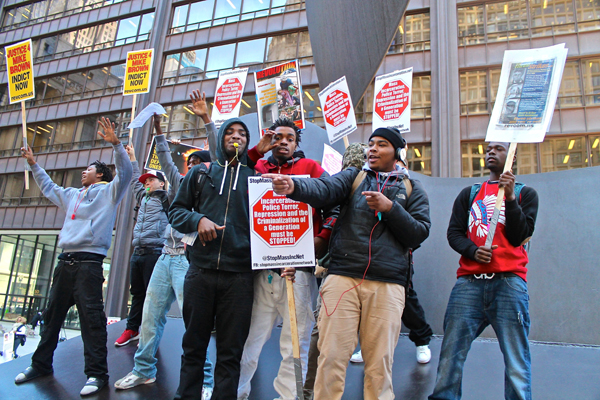
Parents whose children were murdered by police were honored on the stage. Cynthia Lane, mother of Roshad McIntosh, spoke of the heartbreak of losing her 19-year-old son in August to police murder. She and a contingent of family and friends from the West Side demanded that the cop who killed her son be named, indicted, and convicted of murder. Family members of Darius Pinex carried a banner made by his 12-year-old brother that said, "Killer Cop Killed 2 Individuals and Still Has His Job. Justice for Darius Pinex and Flint Farmer."
United Voices for Prisoners, a predominantly Latina/o group demanded their loved ones in prison be treated as human beings and an end to torture and abuse—they brought banners and signs in Spanish and English. Innocents Demand Justice and Anabel Perez exposed the wrongful convictions of their sons and the years-long fights to free them.
Many people from all backgrounds thought it was really powerful to bring together this mix of people to STOP police terror and mass incarceration. It was an overwhelmingly young crowd and they brought their energy and defiance. Several older Black people said they were thrilled a whole new generation, sparked by Ferguson, is standing up and fighting back.
When the march kicked off, with the stolen lives banner in the lead, whistles blowing, it was electric. The youth who are under the gun of the police, many who rarely if ever go downtown, felt emboldened in the march to put their banners and chants and "fuck you" right in the face of the cops. The march headed for State Street, the heart of downtown Chicago. The Pledge of Resistance was read call-and-response style at a corner, then taken up as a chant. "Hands up, don't shoot," the almost universal chant since Mike Brown was murdered, was another favorite, "Indict, Convict, Send the Killer Cops to Jail, the Whole Damned System is Guilty as Hell" was the most powerful. Police were everywhere, trying to contain the march, but couldn't contain the defiance.
Later, after the march circled downtown and arrived at City Hall, 40 protesters marched boldly inside demanding, "Justice for Roshad McIntosh" and the firing of Glenn Evans, the sadistic brutalizing district commander who until he was recently charged, was repeatedly lauded as a model cop and promoted. In the middle of City Hall people blew their whistles and chanted. Protesters spoke bitterly of the way they are treated by the police. "Police look at us like animals. We are human beings! It's not right they shoot kids, they come after us with guns. We have the power to go up against this." "We are standing in City Hall because we know we are right." "All these lives snuffed out—the pictures on the Stolen Lives banner is just a small sample, the problem is much bigger. It's all across the country. There are thousands and thousands of people killed by the police. And we have to stop it." "We will not lay on our backs when they shoot down kids. We will unite and stand up." A member of the Revolution Club said, "We gotta go after the whole system, they do the same to people all over the world."
Returning to Daley Plaza, more speakers were heard. Tio Hardiman, from Violence Interuptors Inc, called for the firing of Glenn Evans and Police Chief McCarthy for promoting Evans. Fred Hampton, Jr. spoke of the murder of his father, a leader in the Black Panther Party, 45 years ago, and how "the pigs are still operating as an occupying army, waging war on the people. They try to criminalize the people and we have to fight back." He gave a salute to the people of Ferguson and called it Mike Brown Town. World Can't Wait came out in orange jumpsuits and made the parallel between the torture in Guantánamo and the torture of 80,000 prisoners in solitary confinement in US prisons, and spoke of the need to resist all the crimes of imperialism here and around the world.
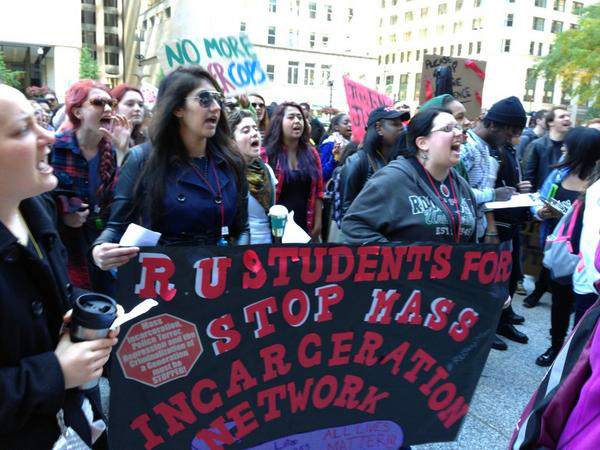
At 6 pm, hundreds protested at the Harrison District police station, called by We Charge Genocide, where the cop who killed Roshad McIntosh is stationed and still has not been named. They protested the Blue Wall of Silence, by putting blue tape over their mouths. Then a spectacular display lit up with Roshad's name. In the evening there was a cultural event at "Rebel Arts."
ROCKFORD, IL
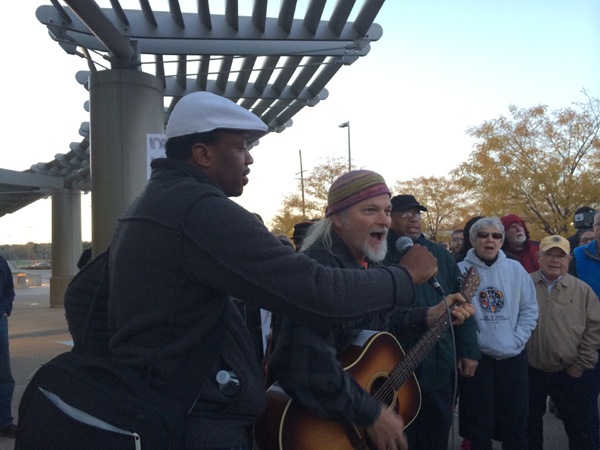
We had a showing of about 75 people. Local media also showed up and even marched with us, including our local National Public Radio affiliate WNIJ. We also had children at our event. It was very racially diverse and contained a lot of excitement and energy for these civil rights concerns that we are marching and gathering for. We had a youth that gave the most powerful message—it highlighted some of Martin Luther King, Jr.'s vivid and related words about the killings of black men in our country. The people here want to see more of these marches.
GREENSBORO, NC
Four very successful events took place for #O22; two major events on campuses (University of North Carolina at Greensboro and Guilford College), each involving about 20-30 participants and reached hundreds—and cops were called on both; demonstration at county jail brought out 70 people, four of whom entered the jail to read the Pledge of Resistance and were threatened with arrest, then came out and read it with the rest of the assembled group; and a rally and march at Smith Homes housing project started with 81 people and included solidarity statements from victims, a minister, and six local organizations and student groups, then marched with drummers through the community and doubled in size. 156 at closing rally (yeah, we counted). Cops were called by the time we got back to the rally point. They said we would be arrested if we did not vacate the parking lot, so we moved onto the grass. Almost completely dissed by local media who received multiple press notices from us, but the events should be covered well by campus papers.
SAN FRANCISCO BAY AREA
Hundreds of people, mainly youth, participated in the day. The Pledge of Resistance captured and concentrated the spirit of new people stepping forward to RESIST until this horror really is "no more." Students from at least 9 high schools and 9 colleges, many organized themselves, bringing signs and banners they had made. Black Lives Matter! All Lives Matter! At least 3 contingents of students had 50 or more youth. Some charter schools from Oakland came with sizeable contingents. 60 students from UC Berkeley came, after first staging a rally on UC's Sproul Plaza where 150 students there participated in the Pledge of Resistance.
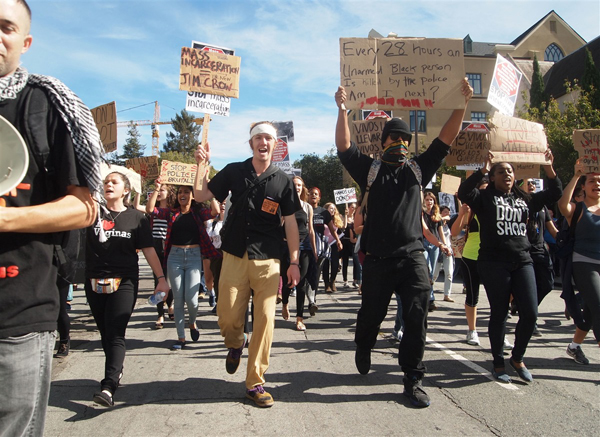
There were also people from every part of Oakland and beyond, including many youth and older Black people from the streets and communities. A number of people there had lost loved ones to police murder: the families of Richard "Pedie" Perez, James Rivera, Mario Romero, and O'Shaine Evans-Murdered by San Francisco Police after a recent Giants playoff game—his family coming straight from O'Shaine's funeral. Dionne Downs, the mother of James Romero, brought a whole crew of youth from Stockton, Ca.
Two dozen members of a local Unitarian Church, led by their pastor, marched onto the plaza. The pastor opened the day with a powerful spiritual reading of the Pledge of Resistance. Different groups of students spoke to why they came. Attorney John Burris spoke, as did Jeralyn Blueford, whose son was murdered by Oakland police. Protesters from Ferguson, Tef Poe and Tory Russell, lit up the crowd with messages of solidarity from the frontlines of St. Louis. Joey Johnson, a Stop Mass Incarceration activist and supporter of RevCom.us, drew in the bigger picture of the need to end all this shit through revolution.
Over 700 copies of Revolution newspaper were distributed along the march and there was an extremely enthusiastic response to the Day from people, especially Black people, in the downtown area.
The fully permitted march was blocked by a phalanx of pigs as it approached the downtown police station. Youth and others stood chest to chest with the riot squad demanding that they be allowed to march, taking to the bull horn and calling the pigs out. The protest did an about face and marched defiantly back to the heart of downtown and marched on Broadway.
An organizer from the Revolution Club challenged everyone who really wanted to end police brutality and the horrors of this system to attend the upcoming dialogue between Cornel West and Bob Avakian.
Interview with a Black woman from UC Berkeley:
Why are you here and what did you think of the day?
I came because of mass incarceration. Because police are killing people for literally nothing. And I am here because these are really all my people, no matter what the skin color. And I am out here because I could easily be one of the people who is shot down for nothing. So I'm waiting for change. I'm waiting for revolution. This was impactful. It made a difference and when I go back to UC Berkeley, we're going to bring this back here and try to figure out what we can do to make actual revolution, actual change. Link arms, let's go. March. Push. I am so ready.
LOS ANGELES
A Black man from South Central who brought his son and a friend to Revolution Books, L.A. after the protest, told everyone: "It's time to get involved. This is my son, I don't want him to be a poster." And he told this story: On O22 he started the day blowing the whistle. "We were at the laundromat, we saw the school police jamming this one guy up, facing the wrong way, this guy was driving the way he was supposed to be, the cop was driving the other way, but he pulled him over, jumped out the car, so I immediately got on the whistle, got my phone, it's like hey, I'm in here, we watch him, ain't no law being broke. If we don't do that, everybody who got a whistle, get out there, cause then your ass might be the one looking for help. It wasn't me getting jammed up, and it's not gonna be me, because I'm older. It's gonna be young Black men, young Mexicans, young white kids in the hood. These are our new voices."
On October 22, family members and friends of more than 12 people killed by police from Bakersfield, Victorville, Long Beach, Anaheim, Compton, Downey and other cities joined by students from college campuses all over Southern California and many others, held a powerful, determined and boisterous march through downtown L.A. that took the fight to end the crimes of police murder and mass imprisonment of our youth to the Criminal Courts, the Metropolitan Detention Center, and to the entrance to LAPD headquarters.
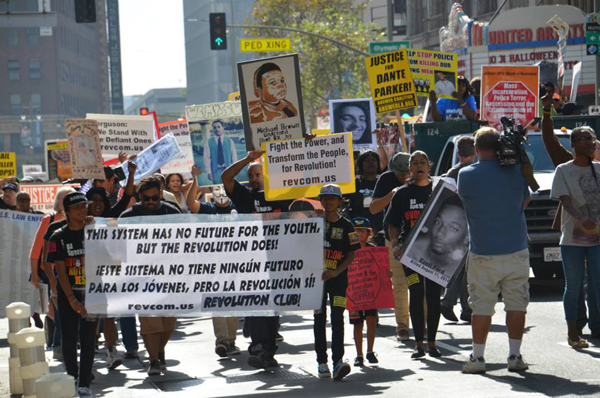
At times the sound of whistles blowing was deafening, as protesters showed how to draw attention to and mobilize others to resist police crimes as they are happening. People lining Broadway sidewalks watched as the marchers filled the air with English and Spanish chants: No More! This stops today! We refuse to live this way! Arrest; indict; put the killer cops in jail. The whole damn system is guilty as hell. Over 400 people took part in the day's events.
The march was filled with the pictures of victims of police violence on placards, carried by their mothers and fathers, their children and friends, as well as others in the crowd. Among the victims whose family members came to speak out were: Tyler Woods; Michael Nida; Steven Bours; Ignacio Ochoa; David Raya; David Silva; Dante Parker; Donte Jordan; Jorge Ramirez; Tony Francis, Jr. and others.
One artist brought beautiful silkscreen posters he'd made of Michael Brown, murdered in Ferguson; Oscar Grant murdered in Oakland; and Trayvon Martin, murdered by a wannabe cop in Sanford, Florida. Another artist made a large sign—"Stop Police Brutality"—that became the backdrop for the speakers on the truck during the rally. Revolutionaries and others carried signs with slogans of the RCP—especially "Fight the Power, and Transform the People, for Revolution." And quite a few in the demonstration were wearing "REVOLUTION—Nothing Less!" t-shirts for the first time.
Some people had traveled long distances from outlying cities and towns to be there. A contingent of 20 people, Black, Latino and white, had come from Bakersfield, a hundred miles north of Los Angeles. They have formed the group Justice League of Bakersfield; one of their banners carried large photos of 5 young men killed by police in Bakersfield.
A contingent of 7 or 8 students from UC Riverside had rallied on campus at noon, before carpooling over an hour to the protest. They had held a speak-out at the campus "Bell Tower" a couple of weeks earlier. And a few days before the 22nd they erected a mock SHU—the solitary confinement cell that tens of thousands of prisoners are held in across the country for years, and decades; learning how to do this from UCLA and Harvard students. Each hour a student had sat silently in the cell from midnight to 11 p.m. A student said on the march:
We're here to support people here and all over the world suffering imprisonment; incarceration, and unjust treatment. Supposedly these people are in prison because of their crimes. Why aren't the people who deserve to be in jail in jail; that's what I'm talking about.
Many in the protest were taking up this call to resistance for the first time, and they were definitely there for a purpose. Over 30 students from an African American Studies class at one of the Cal State Universities came to the rally, along with their professor who had recently returned from Ferguson October. Many said what's happened in Ferguson—the murder of Michael Brown, and the killer cop who still walks free; and the non-stop resistance in Ferguson for nearly three straight months—made them decide they had to join the resistance to mass incarceration, police killings, and the criminalization of Black, Latino and other youth.
A UCLA student described putting up 10 tombstones on campus the week before for people killed by the police—"to make it real to people there." The previous week members of the Revolution Club at UCLA and others erected a mock SHU, and had students sit inside for an hour at a time. On October 1 these students did a public Pledge of Resistance on "Bruin Walk" that was put on TV by the campus station.
At the Criminal Courts Building the poet Jerry Quickley read the poem "Third Degree" by Langston Hughes, and another by June Jordan. And Dawn Franks of Destined Advocacy Alliance Project, condemned the Federal Mandatory Sentencing Laws that pile on years of imprisonment for first offenders.
Gloria Saucedo, the President of Hermandad Mexicana Transnacional, an immigrant rights group serving Mexican, Central and South American immigrants, gave a speech in Spanish and translated, when the march stopped at the Metropolitan Detention Center. A member of the Revolution Club also spoke there.
The main rally was held in front of LAPD headquarters. Reverend Frank Wulf, pastor of the United University Church on the campus of USC, who has played a key role nationally in helping to lead the Month of Resistance, MC'd a very powerful rally with a leader of the Revolution Club. Family members took the stage and told the painful, ugly stories of their loved ones brutally murdered by the police, including Terri Teramura, sister of Michael Nida; Tkeyah Boyd, relative of Tyler Wood; and the family of Dante Parker.
Lisa Bloom, defense attorney and legal analyst for "The Today Show," spoke. She is the author of Suspicion Nation: The Inside Story of the Trayvon Martin Injustice and Why We Continue to Repeat It. And Jim Lafferty of the National Lawyers Guild also made a statement.
Joe Veale gave a statement for the Los Angeles Chapter of the Revolutionary Communist Party, exposing centuries of oppression of Black people and others in the United States; the insanity of living in such a world, and the need for revolution.
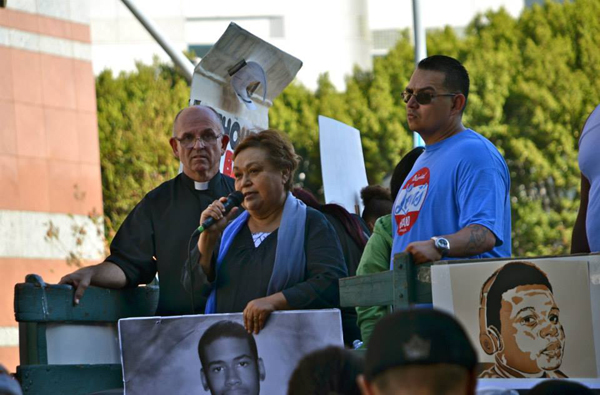
Marie Martin; whose son has been incarcerated for 38 years in the California State Prison System, including many years in solitary confinement, read the poem Gather, by Alice Walker, written and dedicated to Carl Dix and Cornel West, who were the initiators of the October Month of Resistance. And Kamilah Moore—last year's Chair of the UCLA Afrikan Student Union—spoke about the fact that any young Black or Latino youth, or anyone, could be the next one killed by the police.
The march and rally began with the Pledge of Resistance, and a statement from Carl Dix. And it ended on a high note with the crowd reciting the Pledge of Resistance.
The Stop Mass Incarceration Network made clear this movement must continue to grow from here. That includes plans for the October 30 national day of wearing orange, when people everywhere are called on to Wear Orange in support of the prisoners.
Afterwards, many people new to protesting were not ready to end their day, and came back to Revolution Books to eat, meet others and share stories, hear about the protests in other cities, and learn more about BA and the movement for revolution, and the Revolution Club.
The demonstration was covered by both English and Spanish TV stations. La Opinión, the principal daily Spanish language paper for Southern California reported on the protest. The L.A. Times wrote about it in the online edition—and included a link to the Stop Mass Incarceration Facebook page, which has a slide show of photos of many of the demonstrations all over the country.
NEW YORK CITY
On a day marked by courage and defiance, 600 people rallied in Union Square and then took to the streets of New York City, in the face of a lack of permits for the last part of the march in Times Square.
The rally at Union Square was short, marked by one after another family member who had lost their son, their daughter or other loved ones to police brutality, describing what happened, conveying their love for those stolen from them, and their determination to fight so this does not keep happening. Most moving to this reporter was the story one mother told of how her son was wounded by a stray bullet and was being carried to the hospital by friends when police stopped them, and demanded—at gunpoint—that they put him down in the street, within sight of the hospital. As a crowd gathered, the police did put in a call—not for an ambulance or a doctor, but for more police to control the crowd. The young man ended up dying of his injuries.
There had been a tit for tat battle right up to the time the march started over permits, with the New York Police Department (NYPD) steadily refusing to grant permission to march into Times Square, claiming "safety issues." As Carl Dix righteously called out at the Union Square rally, what about the safety of Eric Garner, choked to death by the NYPD, of Ramarley Graham, shot dead by the NYPD in his own bathroom, of hundreds of others killed by the NYPD, and those who will be killed in the future? In the name of the safety of the people Carl declared his determination put his body on the line and march into Times Square, which is in the eyes of the whole world, and he invited everyone else to come with him. At the same time, a plan was made for those who did not want do that to legally rally near Times Square.
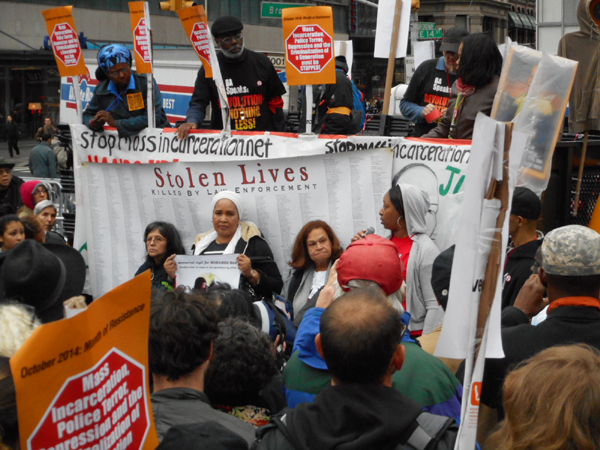
With the danger of police in mind, but with a real awareness of the stakes of resistance, people poured into the streets and began to march, chanting "Raise Your Voice, Raise Your Fist, We Don't Have to Live Like This!" and then "Hands Up, Don't Shoot!"
The crowd was very diverse—whites, Asians, Latinos and Black people—and a large majority were under 25. There were lots of students there from Columbia University's schools of Social Work and Public Health, some of whom had been organized to come by their professor. Some of the Columbia students also informally grouped themselves as white people determined to call out and put an end to racism. Students were also there from Fordham University, Hostos College, the New School, Queens College, City College of New York and St. Joseph's College.
There were quite a few youth as well as older people from the most oppressed sections of society, those who live with police terror every day. The whole march was led by family members of those killed by police or stolen by the prisons, carrying a beautiful Stolen Lives banner. Two people from Harlem carried a homemade banner denouncing the militarized sweeps carried out by the NYPD in the projects there in June.
The Audre Lourde Project gathered a lesbian, gay, bisexual, trans, two spirit, and gender non-conforming people of color contingent at their office to mobilize in solidarity with all peoples affected by hate violence and joined the march at Union Square. Raging Grannies had a contingent; there were members of El Grito de Sunset Park, a group in Sunset Park in Brooklyn that has been leading protests against police brutality. Palestinian activists were in the crowd; people were also there from CopWatch, National Action Against Police Brutality, Stolen Lives Project, Project Reach, anarchists, and others.
This march touched a powerful chord among many people on the street. At one point a group of hard-hatted workers on a rooftop were pumping their fists in support, to cheers from the crowd. At another point a Black woman waiting for a bus was jumping up and down and clapping. A young Black man who was at work in the area and knew nothing about the march in advance left his job to join it.
At one point the NYPD threatened to yank the sound permit for the truck because they said people were not confining themselves to one lane in the street. The lawyers there to represent the demonstrators told the NYPD, "You don't want to arrest these parents." Later, the NYPD said they were giving the protest 1½ lanes because of the number of people.
As the two-mile march approached 40th Street, where the legal permit ended, the police began trying to turn people to the left to the legal rally site. Less than 20 people opted to do that, while the great majority streamed past the police, chanting "NYPD/KKK, How Many Kids Did You Kill Today?" The family members of victims of police along with Carl Dix led the march boldly past the police and on into Times Square, where a non-permitted rally was held in front of the pig precinct there, directly under the Jumbotron.
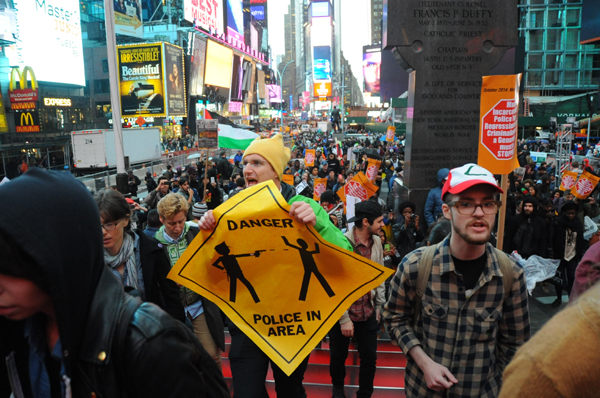
At this point the police split the crowd and put metal barricades close around each of the two divided parts; it really felt like they were getting ready to move in on us. Noche of the Revolution Club spoke, pointing out the importance of people having defied the police to come into the Square, and then called on people to continue to "march, march, march." The crowd again took to the streets and continued to 46th Street, site of the world-famous giant red bleachers, a gathering place for tourists and visitors from across the planet. There, truly in the eyes of the world, the crowd occupied the bleachers and massively declared their determination to continue fighting to put an end to the horrors of police murder, torture in the prisons, attacks on our immigrant brothers and sisters, and all the criminalization of the youth.
The leadership of the Day were definitely capturing the spirit of the people there when they stressed, repeatedly, that this is not a one-time thing, that we will not stop until these horrors are history. And when Carl Dix and other revolutionaries emphasized that it will take revolution to achieve that, this was taken very seriously by many people who had come into the streets to put an end to police terror.
FERGUSON, MO
The October 22 protest in Ferguson called by the recently formed St. Louis Stop Mass Incarceration Network (SMIN) chapter started with people gathering on W. Florissant Ave., a street seen in TV images around the world in August as people rose up after the brutal murder of Mike Brown. The Stolen Lives banner faced the traffic and was greeted by honks from passing cars. One person on the spot organized a National Day of Protest tweeting team, providing tweets for people to send out with photos real time on their cell phones. A short rally began as the crowd gathered. A SMIN rep welcomed the crowd, spoke about the National Day of Protest and the Month of Resistance and its mission to say, and make real, "no more!" Members of Lost Voices, an organization started by homeless youth in the early days of the Mike Brown rebellion and which has been at the center of the upheaval since, spoke. They indicted police terror and the whole system that murders and criminalizes Black people. "America has been run on slavery, empire, and oppression." They declared their determination and challenged others present to not back down in the face of repression and to fight on until justice is won. One organizer, interviewed on Fox 2 News, said, "We are all one, we choose to love and not hate and anything that happens to Black and Brown lives, because they do matter, and Black and Brown communities, it happens to us all." The rally finished with a spirited and determined reading of the SMIN Pledge of Resistance, with people pulling close together to speak it in unison and get it right.
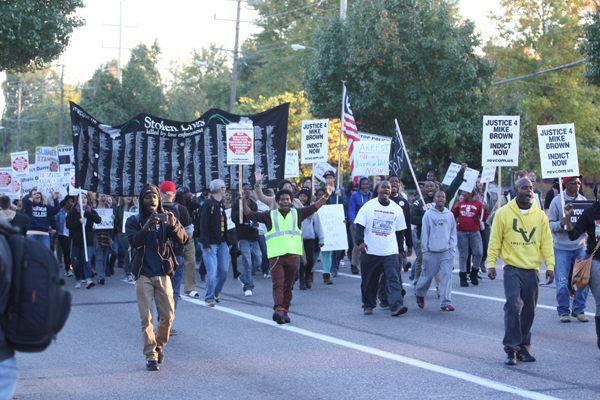
Then people took the streets, taking over one side of Florissant Ave. and stayed in the streets for 3 miles, blocking traffic the whole route. It was loud, defiant, at times jubilant. Cars were a part of the parade-like march, with youth hanging out windows and standing on top waving signs. Mothers walked with children holding signs. Vehicles traveling the opposite direction slowed or stopped to get fliers or take pictures.
Midway along the route, the march veered off a main street and snaked through Ferguson neighborhoods. These are integrated, working class and middle strata neighborhoods, where both "I Love Ferguson" yard signs and people out on their porches waving support were evident. Police helicopters began escorting the march, shining high power lights on protesters from the air.
The march of 200 people included defiant youth who have been in the frontlines of the fight for justice for Mike Brown since Day 1; people from Canfield Apartments where Mike Brown was murdered and his body left in the street for over 4 hours; students from Saint Louis U, Wash U including the Brown School of Social Work, U. Missouri St. Louis, as well as a group from Tulane U. who drove all night from New Orleans to get to Ferguson early that morning. The march was majority Black while about 40% were other nationalities. Protesters were mainly youthful, but it also included older folks, including veterans of struggle, some wearing "vintage" Oct. 22 T-shirts. Members of the Organization of Black Struggle, Hands Up United, Don't Shoot Coalition and the Greens were there, along with people who have been active with St. Louis Stop Mass Incarceration Network. People came from throughout the St. Louis area, including Alton and E. St. Louis, IL.
Visible throughout the march were SMIN Stop Signs and "Justice 4 Mike Brown / INDICT Now! revcom.us" signs. Other signs said: "Darren Wilson WANTED for the Murder of Mike Brown!" "Black Lives Matter!" "Stop Militarizing the Police!" "We Are a Great Force." Homemade signs carried by students made meaningful statements: "SLU (St. Louis University) Medical Students Stand with Ferguson" and "This is What Social Work Looks Like." Carried in the march was a 10 ft. high papier mache puppet of Mike Brown with his hands up, created and carried by artists who said they constructed it because Mike Brown should be present in all the protests.
Non-stop sound of boisterous, energetic chants accompanied the march. Chants included "We wanna indictment, cops don't like it!" "Turn up, don't turn down, We do this for Mike Brown!" "Who shuts shit down? WE shut shit down!" "Indict, Convict, Send the Killer Cop to Jail, the Whole Damn System is Guilty as hell!" "You can't stop the Revolution!"
When the march reached its destination at the Ferguson police station (a site of regular nightly protests for the last 11 weeks), 100 more people were waiting for the demonstration to arrive. Protesters immediately marched up onto the police station property and up to a line of police barriers, which were promptly knocked over. A face-off began with riot police, many carrying rifles loaded with bean bags, cans of mace, and full body shields. The front line of protesters—made up of women and men, multinational and of all ages—stood with locked arms. Across the street from the face-off, an exchange among protesters captured something of the spirit of the night. One protester warned people to stay on the far side of the street if they didn't want to get arrested. Another person responded, "We are here to protest, aren't we?" urging people to go across the street and join people facing off with the line of riot police. And many people did.
At one point in the face-off, a bright light appeared on the wall of a building back across the street. Many raced over to see it and wild chanting and dancing erupted. A giant "Wanted Poster" had been projected on the front of the building: a picture of Darren Wilson with the words "Wanted for the murder of Mike Brown."
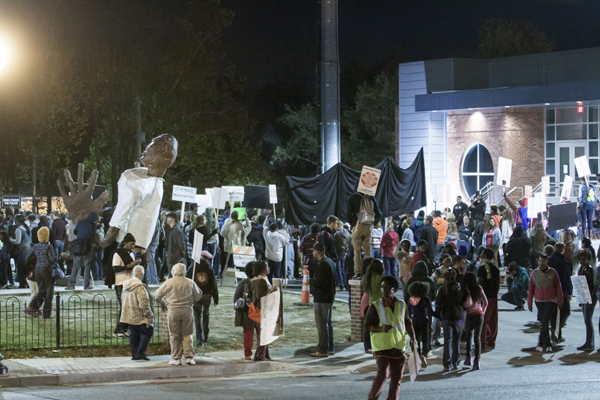
The demonstration at the police station continued late into the night. Five protesters were arrested and released a few hours later.
At the opening rally, 99 people signed up to stay connected with the Stop Mass Incarceration Network. Over 100 copies of Revolution newspaper along with Cornel West-Bob Avakian Dialogue pluggers were distributed during the protest.
The Ferguson protest was covered by Fox Channel 2 News, CBS St. Louis, CNN, St. Louis Channel 4, St. Louis Post-Dispatch, and there was an article run on Common Dreams website on the National Day of Protest focused in Ferguson.
ST. LOUIS
October 22nd National Day of Protest in St. Louis began early in the day with a "mock" funeral procession, initiated by the Organization for Black Struggle (OBS). The action began in Clayton, Missouri where County Prosecutor, Bob McCullough, and other officials continue to maneuver to whitewash the vicious police murder of Michael Brown. A multinational crowd of approximately 50 people attempted to take a glass (mirrored) casket to officials, as a symbolic gesture, to make the point that county officials were being held accountable for the police murders in the district. They attempted to press their way into the front entrance of the St. Louis County police building, defiantly confronting officials massed at the front door. One of the spokespeople declared: "It's been 75 days" referring to the time that the prosecutor's office has been refusing to indict Darren Wilson, the cop that pumped a barrage of bullets into Mike Brown. A chant rang out: "75 days." This soon led to the chant, "Indict Now!" Additional chants included: "No Justice, No Peace!" "What do we want? Justice! When do we want it? Now!" "Indict, convict, send those killer cops to jail...the whole damn system is guilty as hell!" People in the crowd peppered the officials with questions: "Who do you serve?" "Who do you protect?" "Why are you terrorizing our kids?" Later the crowd was able to enter a side door, where they once again faced off with county police and officials who refused them access to the building. Again, chants rang out. The protest included the following: activists from OBS; a number of other individuals and members of other organizations, many of whom were wearing October 22nd t-shirts from years past; and a contingent of "Stop Mass Incarceration" supporters that came there with a large stolen lives banner. Finally protesters headed for their cars and began their funeral procession to the locations of three recent police executions in the St. Louis area.
The funeral procession wound through the streets of St. Louis, disrupting traffic and taking out their message along the way. The first stop was the memorial on Canfield, where 18-year-old Mike Brown was shot six times while his hands were in the air. Continuous mass protests over this killing have been taking place in the suburb of Ferguson for over 75 days. Fresh flowers were placed at the foot of the memorial and there was a moment of silence.
Then the procession headed to the location where, only days after the Brown shooting, 25-year-old Kajieme Powell was shot 12 times, only 20 seconds after police arrived on the scene. The individual, who shot the video that exposed the shooting as another blatant murder, spoke to the crowd. He made the point that this was not a Black/white thing, but those responsible for these killings are the people in the power structure that "pull all the strings".
The final stop of the funeral procession was the intersection of Klemm and Shaw. This is the spot where 18-year-old Vonderritt Myers was shot 17 times by an off-duty cop working as private security. This shooting was immediately followed by a week of massive protests in the streets of South St. Louis. Protesters placed flowers at Vonderrick's memorial and there was a moment of silence. Then his father addressed the crowd, expressing his appreciation for their support and calling on people to keep the momentum going. Those touched by this protest left with a deeper understanding that police murder of young Black people is part of an ugly epidemic.
Some from the funeral procession then headed for the O22 rally and march in Ferguson.
SEATTLE
On October 22 in Seattle, it poured rain, but there was also an outpouring of people, determined that police murder and brutality must STOP. There was a spirit in the air that made it clear the outrage had come to a new level. There were two main events.
About 40 students from Garfield High and other high schools marched from Garfield to a police station after school. They spoke out in front of the station and delivered a statement to the Seattle Police Department (SPD) calling out an SPD officer's public support of Darren Wilson, the notorious murderer of Michael Brown in Ferguson, Mo. It also said, "Though some may argue 'not all cops', when you put on that uniform you are no longer an individual but another force upholding a system of oppression" and "The same system whose origins of American policing are in Runaway Slave Patrols, the entire establishment is rooted in White supremacy and feeds on anti-blackness." (Full statement: www.scribd.com/doc/244000494/Declaration-to-Seattle-Police-Department.) One student reported that the atmosphere coming from the police at the station during this action was "hateful."
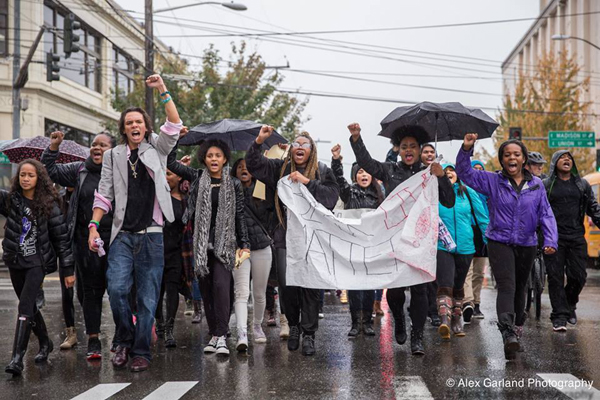
Soon after this, during the busy rush hour in Seattle's Capitol Hill area, about 100 people gathered to rally and march. The speakers included families of people killed by the police sharing their stories of loss; an immigrant activist and hunger striker fighting detentions and deportations; and Jen Marlowe, co-author of the book I Am Troy Davis. The crowd was diverse: high school and college students, Black and white, middle class and homeless people, political activists and revolutionaries, as well as first-time protestors who found out about the action through social media or seeing posters on the street. The spirit of and deep respect for Ferguson was in the house, as people listened intently when a revolutionary read the October 22nd statement by Carl Dix, which called on people to act to END the horrors and continue beyond October. People cheered with fists up when they heard that protesters had taken Times Square in NYC, and that protests were happening in 75 locations nationwide!
The plan had been to march and gather forces along the way before heading to the closest police station. However, people were so fired up that they marched straight towards the station, a hangout of the dreaded SPD, murderers of so many in Seattle over the years. But when still a full block away from it, they found an incredible multi-layered force blocking their way. First was a steel barricade, then behind that a row of cops on foot holding not night sticks but heavy clubs three feet long. Behind that was another row of cops with bicycles ready to use as blocking devices to hem people in. And behind them, a row of cops mounted on big horses, standing ready to run down on people. There were even police appearing far up on the roof of the station, apparently as snipers!
All this was to prevent a group of unarmed humans, who had done no violence, from approaching anywhere near their police station, to simply verbally confront the station and those within with their ongoing crimes against the people.
But the people did not turn back, and came up hard against the barricade, chanting "let us through!" and calling out in righteous fury all the many names of those killed by the SPD, demanding they be able to pass. Police hurried to pull out tear gas and bundles of plastic hand cuffs. A big speak out was held here right at the barricades, with students from the Black Student Union at Seattle Pacific University and more family members speaking out with great emotion, some directly shouting to the police and demanding answers. People really got down and testified here. A woman who was born intersex told about the poking, humiliation, and ridicule she had been subjected to when arrested, and people cheered in support of her defiance. An angry and heartbroken mother spoke out to local television media about her daughter who had been shot dead by the police after refusing to roll down her car window in a botched drug bust. One thing that was also striking was the white youth who spoke, their outrage over Ferguson and police brutality in general and their awareness that it is right to stand with those who are most under the gun of this system.
Revolutionaries agitated about the utter illegitimacy of not allowing people to nonviolently protest in front of their station while they are murdering innocent Black and brown people in epidemic proportions, but how this is no surprise because pigs will be pigs and the role of the police is not to serve and protect the people, but to enforce this unjust system over the people. At one point a spokesperson for the march, by bullhorn, asked this large formation of police to put forward someone responsible for responding to this request of people to make their rightful way in the street. The response was a chilling silence.
The protesters then decided to take the chant to "indict, convict, send the killer cops to jail—the whole damn system is guilty as hell!" to more people by marching down the busiest street, stopping along the way to block key intersections. Suddenly, at one intersection, multiple large cops were piled on something on the ground. They were stacked all over it so much you could not even see what it was. It was literally a PIG PILE. Then they picked up what they had been on top of—a human being, tightly bound up. They swiftly carried the person horizontal like a piece of lumber, and stuck them in a vehicle as everyone yelled "let them go!" It was a youth, and not a large person, and it was ugly how there were so many cops down on top of this person. People attended court in support of this person the next day, and they are now out of jail and in good spirits but facing charges of "assault."
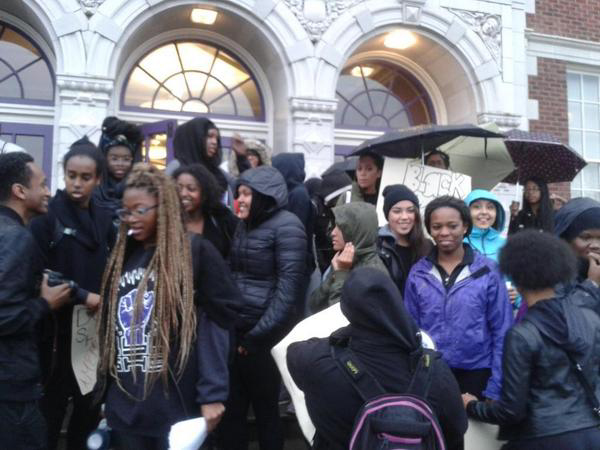
All this was happening during periods of rain. As the march came back near its start point and dispersed, many remained gathered in the rain and darkness to share connections and talk about the need to build further actions, and how we will end these horrors once and for all.
During the evening, the upcoming Dialogue between Bob Avakian and Cornel West on Revolution and Religion: The Fight for Emancipation and the Role of Religion, was also made known to people. Some were immediately interested, wanting to know more and be involved in some way. One person expressed interest in going, and a teacher said he would tell his students about it, and wanted to know how he could donate, that some of his students might want to go as a crew. Plans were made to meet about raising funds to make this possible right away.
SAN DIEGO
Over 200 participated in a march in City Heights in San Diego, organized by United Against Police Terror-San Diego and Af3irm San Diego. Shakina Ortega whose husband Victor Ortega was shot by the San Diego police in June 2012 was among those who came to protest. She told news reporters, "It's been hard. I can't see my best friend, my husband anymore. My kids don't have a father anymore....Why is he [the cop] still working and my husband is not here with his kids? For what? That I can't get over that and that's why I'm going to be fighting." Cathy Mendonça of United Against Police Terror, one of the organizers, said, "You can't trust police," and called on people to "Film them at all times. Encourage everyone it is your right if you're out in public it is your right to film police." Mendonça said.
CLEVELAND
O22 began with 55 people forming up at the Ohio women's prison, with all kinds of signs and mock prison bars. With the prison population of women exploding all over the country, this was a fitting place to start the protest. Facing the entrance of the prison, we read the Pledge of Resistance dedicated to the women incarcerated there. Then we took off marching and stopped in front of the Cleveland State University student center. With high spirits and loud chants of "Hands Up- Don't Shoot", we marched inside electrifying the atmosphere as students on the main floor and hanging over balconies listened as we again recited the Pledge. As soon as the words "Black Lives Matter" were spoken, a table of young Black women responded with an enthusiastic—"damn it's about time we heard something like that."
With spirited chants we marched out of the center to downtown with supportive responses from many pedestrians and drivers, including a bus driver honking and throwing us the v sign. Whistles accompanied chants of "Indict, Convict, Send those Killing Cops to Jail, the Whole damn System is Guilty as Hell!" Horns blew in support. At the downtown rally the crowd grew to 150 with many people joining off the street. The crowd was very multi-national with about half being youth and students and many people active in different social movements. Pictures of people whose lives have been stolen by killer cops were lined up along the front of the make-shift stage. Several high school youth who were downtown took some blank signs and wrote "FUCK 12" on them, meaning "FUCK the POLICE" They held them up for a while and then left with the signs. A mock prison cell stood at the center of the square, from where people testified about their experiences with prison and the cops . The outrage against the brutal killing two years ago of Melissa Williams and Timothy Russell when police fired 137 shots was still fresh on people's minds.
Puncture the Silence-Stop Mass Incarceration, the main local organizing force behind the protest, mc'd and spoke to the magnitude of mass incarceration and police murder. Several families of people killed by the police spoke to the heart-break and anger of losing loved ones, and called for continued resistance and protest. Spoken word artists gave expression to the experience of growing up Black in this racist country, a person from Revolution newspaper spoke to people about the need for revolution and called on people to get on the bus to hear the BA-Cornel West Dialogue. A leader of the local chapter of CAIR (Council on American Islamic Relations) spoke about the attacks and deportations of immigrants and how that must stop. There were people who spoke from the Student Socialist Club from Cleveland State University, Black on Black Crime, the spoken word group Distinguished Gentlemen, New Black Panther Party, and others.
After the rally the Revolution contingent led a militant march of about 30 people to the "Justice" Center. Once there, we held up signs of the victims that had been murdered by the police up against the glass yelling "Hands up Don't Shoot". After chanting outside for about 15 minutes, we decided to march inside and were immediately confronted with sheriffs who forced us back outside after an exchange of angry words as some protesters screamed in their faces.
As we marched back, about 12 youth saw us coming and loved it. They immediately joined in shouting "Hands up. Don't shoot." As dusk began to settle, people talked about the way forward, building resistance to the many horrors of this system, about Bob Avakian's leadership¸ about the Dialogue coming up on November 15, and how excited people were to be a part of this protest, determined that this day was the beginning of the end to this new Jim Crow.
At the end, a young white woman almost yelling and with tears in her eyes told a Revolution seller, "I told the cops we were here, and have the right to be here [at the Justice Center] and we are angry. I told the cop we are nine times more likely to be killed by a police officer than a fucking terrorist attack. What is the real scare, it's the police. They've been around for 200 fuckin years and been crooked ever since. Racism has never dwindled, it's still the same, always been and I am fuckin sick of it."
Volunteers Needed... for revcom.us and Revolution
If you like this article, subscribe, donate to and sustain Revolution newspaper.
